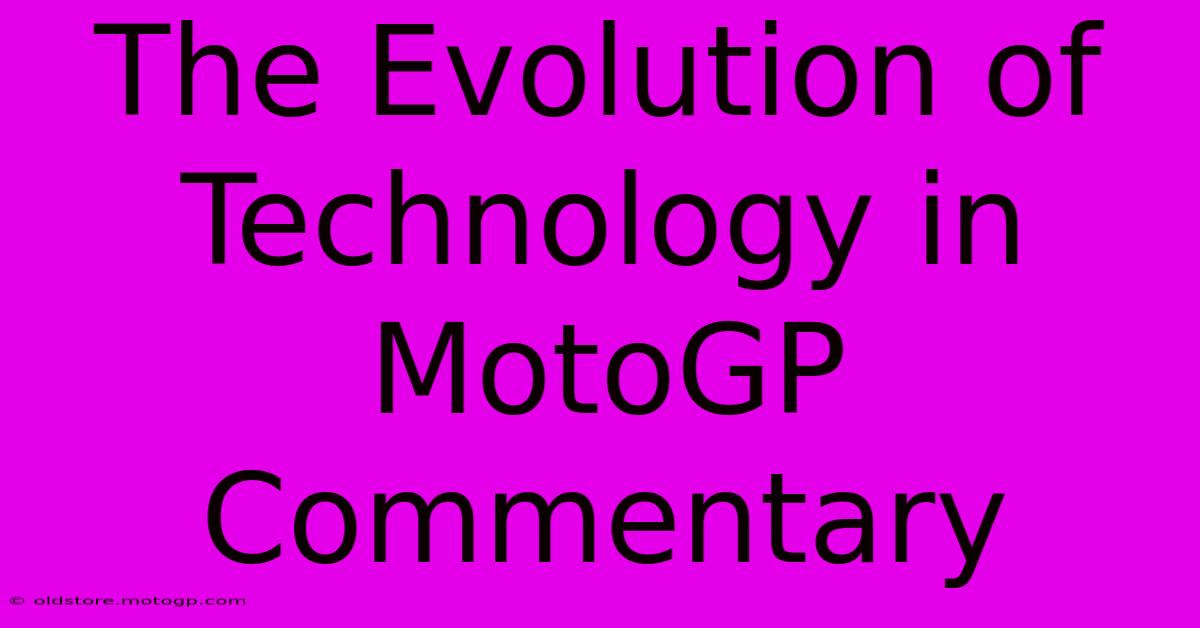The Evolution Of Technology In MotoGP Commentary

Table of Contents
The Evolution of Technology in MotoGP Commentary: From Crackly Radios to Immersive Experiences
MotoGP, the pinnacle of motorcycle racing, isn't just about the speed and skill of the riders. The experience is significantly enhanced by the commentary, a vital element that bridges the gap between the track and the viewer. Over the years, the technology behind MotoGP commentary has undergone a dramatic evolution, transforming from basic radio broadcasts to sophisticated, immersive experiences. This article explores this fascinating journey.
From Humble Beginnings: The Early Days of Radio Commentary
The earliest days of MotoGP commentary relied heavily on basic radio technology. Commentators, often located trackside, relied on their own observations and limited communication channels. The audio quality was often poor, with crackly transmissions and limited access to real-time data. The experience was largely about capturing the atmosphere and relaying basic race information. Think grainy black and white footage coupled with a voice echoing across the airwaves. The human element was paramount, with commentators' passion and knowledge compensating for technical limitations.
The limitations of early technology:
- Limited audio quality: Crackling audio and background noise were common.
- Restricted data access: Commentators had limited access to real-time lap times, speeds, and other critical data.
- Reliance on visual observation: Commentators relied primarily on their own eyesight to describe the race events.
The Rise of Television and Enhanced Data Access
The advent of television broadcasting revolutionized MotoGP commentary. High-definition cameras provided stunning visuals, allowing viewers to witness the race in unparalleled detail. This visual richness demanded a more sophisticated commentary approach. Simultaneously, the integration of timing and telemetry systems provided commentators with real-time data. This allowed for a more analytical and insightful commentary, moving beyond simple race descriptions to deep dives into strategic nuances and rider performance.
Television's Impact:
- Enhanced visuals: High-definition cameras showcased the speed and excitement of the race.
- Real-time data integration: Access to lap times, speeds, and other data enriched the commentary.
- Increased audience engagement: The visual spectacle and enhanced information captivated larger audiences.
The Digital Revolution: Interactive Commentary and Beyond
The digital age brought about a new wave of technological advancements, further enhancing the MotoGP commentary experience. Live timing applications, integrated into broadcasting, provided viewers with detailed race information at their fingertips. Social media integration allowed commentators to interact with viewers in real-time, fostering a sense of community and engagement. The use of multiple camera angles and onboard cameras provided unprecedented access to the race from different perspectives, offering a more immersive experience for the audience.
The Digital Era's Advancements:
- Live timing applications: Viewers could access real-time race data independently.
- Social media integration: Increased fan interaction and community building.
- Multiple camera angles and onboard cameras: Immersive viewing experience.
- Enhanced graphics and visualizations: Improved understanding of race dynamics.
The Future of MotoGP Commentary: AI and Immersive Technologies
The future of MotoGP commentary promises even greater advancements. Artificial intelligence (AI) could play a significant role, providing commentators with predictive analytics and in-depth insights into rider performance. Virtual reality (VR) and augmented reality (AR) technologies could offer viewers completely immersive experiences, placing them right in the heart of the action. We can anticipate more sophisticated data visualizations, personalized commentary options, and potentially even interactive commentary where viewers can influence the narrative.
Looking Ahead:
- AI-powered analytics: Predictive analysis and deeper insights into rider performance.
- VR/AR integration: Immersive viewing experiences for fans.
- Personalized commentary: Tailored to individual viewer preferences.
- Interactive commentary: Viewers influencing the narrative.
The evolution of technology in MotoGP commentary mirrors the evolution of the sport itself. From humble beginnings with basic radio broadcasts, we've progressed to a highly sophisticated and immersive experience. The future promises even more exciting advancements, ensuring that MotoGP fans continue to enjoy the thrill of the race with increasingly rich and engaging commentary.

Thank you for visiting our website wich cover about The Evolution Of Technology In MotoGP Commentary. We hope the information provided has been useful to you. Feel free to contact us if you have any questions or need further assistance. See you next time and dont miss to bookmark.
Featured Posts
-
Cota Open Track Days The Perfect Gift For Car Lovers
Feb 20, 2025
-
The Ultimate F1 Fan Experience Book A Shuttle
Feb 20, 2025
-
Moto2 Specs The Future Is Now
Feb 20, 2025
-
The Greatest Moto Gp Rider The Definition Of Greatness
Feb 20, 2025
-
The Ultimate Guide To American Moto Gp Riders
Feb 20, 2025
